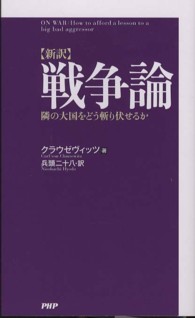- ホーム
- > 洋書
- > 英文書
- > Computer / General
Full Description
Get up to speed on Application Lifecycle Management (ALM) with Visual Studio 2010 through a combination of hands-on instruction and deep-dives.
Microsoft has packed a lot of brand new testing and modeling tools into Visual Studio 2010, tools that previously were available only to Microsoft internal development teams. Developers will appreciate the focus on practical implementation techniques and best practices.
A team of Microsoft insiders provides a nuts-and-bolts approach. This Wrox guide is designed as both a step-by-step guide and a reference for modeling, designing, and coordinating software development solutions at every level using Visual Studio 2010 and Visual Studio Team Foundation Server 2010.
Visual Studio 2010 offers a complete lifecycle management system that covers modeling, testing, code analysis, collaboration, build and deployment tools.
Contents
INTRODUCTION xxix PART ISOFTWARE ARCHITECTURE 3
Designing Visually 3
Microsoft s Modeling Strategy 4
From Objects to Services 7
New Architecture Tools in Visual Studio 2010 Ultimate 10
Summary 15
CHAPTER 2: TOP-DOWN DESIGN WITH USE CASE DIAGRAMS, ACTIVITY DIAGRAMS, AND SEQUENCE DIAGRAMS 17
Use Case Diagrams 18
Activity Diagrams 22
Sequence Diagrams 28
Summary 31
CHAPTER 3: TOP-DOWN DESIGN WITH COMPONENT AND CLASS DIAGRAMS 33
Component Diagrams 34
Class Diagrams 46
Summary 58
CHAPTER 4: ANALYZING APPLICATIONS USING ARCHITECTURE EXPLORER 59
Understanding the Code Base 60
Architecture Explorer Basics 61
Dependency Graphs 71
Summary 80
CHAPTER 5: USING LAYER DIAGRAMS 81
Creating a Layer Diagram 82
Defining Layers on a Layer Diagram 83
Defining Dependencies 86
Validating the Layer Diagram 88
Layer Diagrams and the Build Process DEVELOPMENT 95
What s New for Developers in Visual Studio 2010 96
Test Impact Analysis 97
Improved Code Analysis 97
Profiler Enhancements 97
Database Extensibility 97
Advanced Debugging with IntelliTrace 98
Improved Test-First Development Experience 98
Summary 98
CHAPTER 7: UNIT TESTING WITH THE UNIT TEST FRAMEWORK 99
Unit Testing Concepts 100
Visual Studio Unit Testing 102
Programming with the Unit Test Framework 110
Accessing Nonpublic Members from Tests 122
Code Generation 126
Code Coverage 129
Test Impact Analysis 131
Summary 137
CHAPTER 8: MANAGED CODE ANALYSIS AND CODE METRICS 139
The Need for Analysis Tools 140
Using Managed Code Analysis 140
Using the Command-Line Analysis Tool 151
Creating Code Analysis Rules 155
Code Metrics 163
Summary 165
CHAPTER 9: PROFILING AND PERFORMANCE 167
Introduction to Performance Analysis 168
Using the Profiler 169
Command-Line Profiling Utilities 195
Common Profiling Issues 198
Summary 199
CHAPTER 10: DATABASE DEVELOPMENT, TESTING, AND DEPLOYMENT 201
The Challenges of Database Change Management 202
Offline Schema Development 203
Creating a Database Project 207
Examining the Database Project 212
Making Schema Changes 215
Deploying Database Changes 221
Data Generation 224
Database Testing 227
Summary 241 IntelliTrace 243
New Features in Breakpoints 251
Pinnable Data Tips 253 TESTING 259
Role-Based Testing Tools 260
Types of Tests 260
Diagnostic Data Adapters 262
Microsoft Test Manager 264
Managing Automated Tests with Visual Studio 265
Summary 276
CHAPTER 13: WEB PERFORMANCE AND LOAD TESTING 277
Web Performance Tests 278
Load Tests 297
Command-Line Test Execution 312
Distributed Load Tests 313
Summary 317
CHAPTER 14: MANUAL TESTING 319
Microsoft Test Manager 319
Using Test Plans 320
Running Tests and Tracking Results 330
Running Automated Tests 336
Summary 338
CHAPTER 15: CODED USER INTERFACE TESTING 339
Creating Coded UI Tests Using the Coded UI Test Builder 340
Creating Coded UI Tests Using Action Recordings 351
Supported Technologies 354
Summary 354
CHAPTER 16: LAB MANAGEMENT 357
Lab Management Infrastructure 358
Virtual Environments 360
Testing with Virtual Environments 366
Automated Build-Deploy-Test with Virtual Environments 371
Physical Environments 375
Summary 376 PART SERVER 379
What Is Team Foundation Server? 380
Team Foundation Server Core Concepts 380
Accessing Team Foundation Server 392
What s New in Team Foundation Server 2010 400
Adopting Team Foundation Server 402
Summary 404
CHAPTER 18: TEAM FOUNDATION ARCHITECTURE 405
Team Foundation Server Logical Architecture 406
Physical Architecture 412
Deployment Scenarios 415
Summary 421
CHAPTER 19: TEAM FOUNDATION VERSION CONTROL 423
Team Foundation Version Control and Visual
SourceSafe (VSS) 2005 424
Setting up Version Control 425
Using the Source Control Explorer 427
Check-In and Check-Out 432
Shelving 438
Branching and Merging 440
Command-Line Tools 444
Summary 445
CHAPTER 20: BRANCHING AND MERGING 447
Understanding Branching and Merging 448
Common Branching Strategies 449
Basic Branching Plan 452
Advanced Branching Plan 467
Summary 470
CHAPTER 21: TEAM FOUNDATION BUILD 471
Team Foundation Build 472
What s New in Team Foundation Build 2010 474
Team Foundation Build Architecture 477
Working with Builds 478
Team Build Process 492
Summary 517 PART V: PROJECT/PROCESS Project Setup and Configuration 522
Planning Your Project 528
All Things Work Items 529
Using MS Office with Team Foundation Server 538
Summary 547
CHAPTER 23: PROCESS TEMPLATES 549
Understanding a Process Template 550
Process Templates Out of the Box 551
Partner and Community Templates 568
Summary 569
CHAPTER 24: USING REPORTS, PORTALS, AND DASHBOARDS 571
Team Foundation Server Reporting 572
Working with Team Foundation Server Reports 575
Summary 596
CHAPTER 25: AGILE PLANNING USING PLANNING WORKBOOKS 599
Product Backlog 600
Product Planning Workbook 602
Iteration Planning 607
Iteration Backlog Workbook 608
Tracking the Iteration 613
Summary 614
CHAPTER 26: PROCESS TEMPLATE CUSTOMIZATIONS 615
Customizing Process Templates 616
Tools for Customization 620
Uploading Process Templates in Team Foundation Server 631
Deleting Process Templates 631
Customizing Process Guidance 632
Summary 632
INDEX 633








